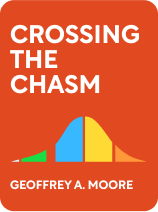

This article is an excerpt from the Shortform book guide to "Crossing the Chasm" by Geoffrey Moore. Shortform has the world's best summaries and analyses of books you should be reading.
Like this article? Sign up for a free trial here .
What is the difference between innovators and early adopters? What are their motivations for trying out new, experimental technology?
Innovators and early adopters represent the two early-market categories of customers in the Technology Adoption Life Cycle (TALC). Innovators are technology enthusiasts: they are the first to try out new technologies for its own sake. Unlike the innovators, early adopters are not interested in new technology for its own sake, but rather in the new advantages it may afford.
We’ll take a look at the key characteristics of both groups below.
Innovators
The first category of customers represented in the TALC is made up of “innovators.” Innovators value innovative technology for its own sake. They buy new or experimental products just to try them out because they want to be on the cutting edge and participate in advancing the state of the art. Moore characterizes innovators as follows:
- Population size: About 2% of the total population.
- Technical Competence: Extremely high. Moore observes that innovators can get by with minimal operating instructions, and they’ll often invest their own time in debugging your product.
- Quality Requirements for your product: Low. They are used to working with products that don’t have all the bugs worked out of them yet.
- Price Sensitivity: High. Moore notes that innovators typically operate on a limited budget, and some of them believe that technology should be free or provided at-cost. (Shortform note: It seems likely that most innovators would be in technical rather than executive roles in a company. This would limit their budget and their ability to place large orders for their company, consistent with Moore’s characterization.)
- Whole-Product Perspective: Innovators don’t need whole products, because they take pleasure in assembling components into working systems for themselves.
- Product Positioning Perspective: According to Moore, innovators assess your product’s positioning on a purely technical basis. To help them evaluate where it fits relative to other technology, they look for schematics, demonstrations or user trials, and endorsements from respected technology gurus. They tend to communicate broadly, both within and outside of their own industry or community, to keep abreast of new technological developments.
| Beal and Bohlen’s Perspective on Innovators According to Beal and Bohlen’s original characterization, innovators, by definition, are the first people in their respective communities to adopt new technology. They report that there are usually only one or two of them in a local community, corroborating Moore’s assessment of their population size. Beal and Bohlen report that innovators typically have high net worth, and most importantly, they have large amounts of “risk capital.” They can afford to buy new technology just to try it out. This contradicts Moore’s assertion that innovators are more price-sensitive. Perhaps the price sensitivity of innovators is context-specific. An engineer working in industry might have a limited budget for assessing experimental technologies, while a self-employed farmer would only be able to experiment with new agricultural technologies if he had the money to do so. According to Beal and Bohlen, innovators are typically influential people in their communities, with many connections outside their local community as well. This description corroborates Moore’s assertion that innovators tend to communicate broadly. |
Early Adopters
Both innovators and early adopters are enthusiastic about trying new technology but early adopters don’t do it for its own sake. Moore prefers to call them “visionaries,” because most of them are ambitious leaders looking to gain a strategic advantage or make a quantum leap forward by leveraging new technological breakthroughs.
- Population size: About one sixth of the population.
- Technical Competence: High. Moore observes that a typical early adopter has the technical insight to identify and implement strategic technologies, as well as the charisma to rally his company around the project.
- Quality Requirements for your product: Moderate. Moore describes early adopters as being comfortable accepting the risk of unproven technology because they envision it providing great benefits. However, he also notes that their expectations often exceed the product’s actual capabilities, making them difficult customers to please in the long run.
- Price Sensitivity: Lowest. Moore asserts that early adopters are usually corporate executives with resources to fund ambitious projects.
- Whole-Product Perspective: According to Moore, early adopters are willing to take responsibility for assembling the whole product because they want to be the first to leverage its capabilities.
- Product Positioning Perspective: According to Moore, early adopters assess your product’s positioning based on how it fits into their vision for the future or could help them realize their ambitions. They communicate broadly to keep an eye out for new technologies with strategic applications, and evaluate them based on technical benchmarks, product reviews, initial sales metrics, and trade press coverage.
| Beal and Bohlen’s Perspective on Early Adopters According to Beal and Bohlen’s original characterization, early adopters tend to be younger and more highly educated than members of the early and late majority. They are well-read and stay well-informed, receiving more technical or agricultural publications than the majority do. Moore echoes Beal’s assertion that early adopters are well-informed and communicate broadly, especially through publications, but he does not address their average age or level of education. Perhaps these characteristics were more pronounced in the population that Beal and Bohlen studied. For example, perhaps in a farming community, the average farmer has a two-year degree or equivalent, while early-adopter farmers have graduate-level degrees. Meanwhile, the average office worker of a Silicon Valley manufacturing company has a graduate-level degree, and so highly-educated early adopters don’t stand out as being significantly more educated than the rest of the population. Beal and Bohlen state that early adopters are also the most likely to hold public office or otherwise be formally involved in the institutions of their respective communities. Moore makes no mention of this, but does say that early adopters usually hold executive positions in their respective companies. Perhaps early adopters in rural farming communities tend to be more involved in municipal politics, while early adopters in advanced manufacturing companies tend to be more involved in corporate politics. After commenting that innovators tend to have large amounts of risk capital available, Beal and Bohlen offer no comment on the financial status of early adopters. This contrasts with Moore’s description, since Moore identifies early adopters as having the most funding available to spend on cutting-edge technology, while innovators are much more price sensitive. |

———End of Preview———
Like what you just read? Read the rest of the world's best book summary and analysis of Geoffrey Moore's "Crossing the Chasm" at Shortform .
Here's what you'll find in our full Crossing the Chasm summary :
- An explanation of the chasm phenomenon that many new high-tech products face
- How to pilot a product across this chasm to mainstream success
- The problems with the Technology Adoption Life Cycle (TALC) model






